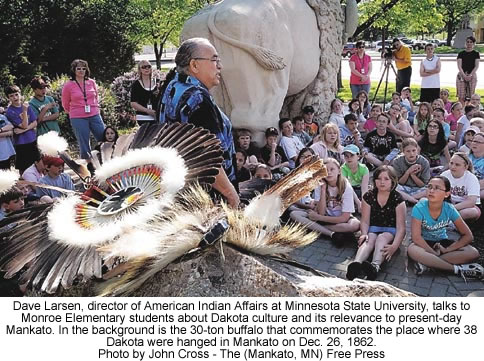 |
Canku Ota
|
 |
|
(Many Paths)
|
||
|
An Online Newsletter
Celebrating Native America
|
||
|
June 1, 2010 - Volume
8 Number 6
|
||
|
|
||
|
Monroe Students Connect
With Native American History
|
||
|
by Tanner Kent - The
(Mankato, MN) Free Press
|
||
|
Reconciliation Park Is Site For Learning MANKATO — After almost 150 years, the Monroe 74 finally met the Dakota 38 on Wednesday.
The field trip was part of a social studies unit. But, perhaps more importantly, the trip allowed students to connect personally with the history and meet face-to-face the people who have helped bridge the chasm between present-day Mankato and the tragic events that took place on Dec. 26, 1862, when 38 Dakota were hanged near the exact spot the buffalo sits today. "I just liked the whole entire experience of being here and learning about the Dakota," student Casey Schultz said. The students met Bud Lawrence, the Mankato man who helped start the annual Wacipi, or Powwow, in Mankato to begin healing the rift with the Dakota people. They also met Dave Larsen, director of American Indian Affairs at Minnesota State University and a Dakota himself, who travels the country to speak about the importance of recognizing and embracing Native American culture. Larsen told students how Native American children were once made to change their names because their teachers, of European heritage, couldn't pronounce them. He talked about the impact of words like "Sioux" and "squaw," which were somewhat derogatory terms white settlers coined but have no meaning to Native American people. Larsen showed students his eagle-feather fan and an elaborate waistpiece made of eagle feathers used in ceremonies. He talked about the Native American values of peace, humility and love and told students the systematic destruction of Native heritage has left painful scars. "Almost all the information people got about us was wrong for hundreds of years," Larsen said. The field trip was the brainchild of Steve Miller, a fifth-grade math and social studies teacher at Monroe. He said fifth-graders learn American history up to the the Civil War, but there is little mention in the curriculum about the Dakota Conflict and its widespread impacts on southern Minnesota. Wanting to find a way to make that history meaningful for students, Miller said he decided to find the people and places who could tell the story better than anyone. Miller said the topic not only holds local historical significance but also holds messages still relevant today — messages about acceptance, equality and co-existence. "This started as a simple lesson," he said. "And it turned into something the kids will always remember." Janessa Mulder said she knew about Mankato's Native American history before Wednesday's field trip. She said it's important for all students to know the same history so the cycle of intolerance doesn't continue: "It's important because some kids make fun of (Native American culture) and think Indians aren't as good as other people." Sharing with students his involvement in bringing the annual Wacipi to Mankato, Lawrence told students about his longtime friend Amos Owen, a well-respected elder in the Dakota community who helped him organize the first event in 1972 along with a group of Dakota men and women. Lawrence said no one was sure how many people would show up for the first Wacipi as some feelings on both sides remained bitter. But thousands attended the inaugural celebration — including 38 eagles that eyewitnesses swear circled the skies that day. "I think this is very important for these kids," Lawrence said. "The history books don't adequately cover what happened. This reveals the entire story." |
|
insert map here
|
|
|
||
|
|
||
| Canku Ota is a free Newsletter celebrating Native America, its traditions and accomplishments . We do not provide subscriber or visitor names to anyone. Some articles presented in Canku Ota may contain copyright material. We have received appropriate permissions for republishing any articles. Material appearing here is distributed without profit or monetary gain to those who have expressed an interest. This is in accordance with Title 17 U.S.C. Section 107. | ||
|
Canku Ota is a copyright ©
2000, 2001, 2002, 2003, 2004, 2005, 2006, 2007, 2008, 2009, 2010
of Vicki Barry and Paul Barry.
|
||
 |
 |
|
|
The "Canku
Ota - A Newsletter Celebrating Native America" web site and
its design is the
|
||
|
Copyright ©
1999, 2000, 2001, 2002, 2003, 2004, 2005,
2006, 2007, 2008, 2009, 2010
of Paul C. Barry.
|
||
|
All Rights Reserved.
|
||
 Leaving
school around 9 a.m., Monroe Elementary's entire fifth-grade class
of 74 students walked across Veterans Memorial Bridge from North
Mankato to gather for a combined history and art lesson at Reconciliation
Park. The park is home to the 30-ton buffalo that serves as a symbol
of respect and remembrance for the largest mass execution in United
States history.
Leaving
school around 9 a.m., Monroe Elementary's entire fifth-grade class
of 74 students walked across Veterans Memorial Bridge from North
Mankato to gather for a combined history and art lesson at Reconciliation
Park. The park is home to the 30-ton buffalo that serves as a symbol
of respect and remembrance for the largest mass execution in United
States history.